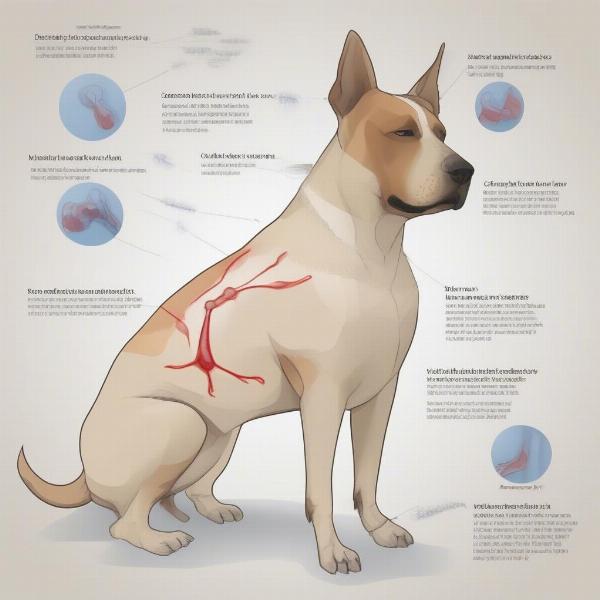Pressure sores, also known as bedsores or decubitus ulcers, are a serious health concern for dogs, especially those with limited mobility. These sores develop when prolonged pressure restricts blood flow to the skin and underlying tissues. Understanding the causes, symptoms, treatment, and prevention of pressure sores is crucial for ensuring your dog’s comfort and well-being.
What Causes Pressure Sores in Dogs?
Pressure sores typically occur over bony prominences where there is minimal cushioning between the bone and the skin. Common locations include the elbows, hips, hocks (ankles), and shoulders. Immobility is a primary factor, as dogs who are unable to shift their weight regularly are at increased risk. Other contributing factors include obesity, poor nutrition, inadequate bedding, and underlying health conditions that compromise circulation.
 Pressure Sores Locations on a Dog
Pressure Sores Locations on a Dog
Recognizing the Signs of Pressure Sores
Early detection is key to managing pressure sores effectively. Initial signs may include reddened skin that doesn’t blanch when pressed, hair loss over the affected area, and swelling or hardening of the skin. As the sores progress, they can develop into open wounds, potentially becoming infected and causing significant pain.
Treating Pressure Sores in Dogs
Treatment for pressure sores depends on the severity of the wound. Mild cases may respond to conservative management, such as frequent repositioning, providing soft bedding, dog beds for large dogs australia and wound cleaning. More severe sores may require veterinary intervention, including bandaging, antibiotics, pain management, and in some cases, surgery.
“Early intervention is essential for successful treatment of pressure sores. The sooner you address the issue, the better the prognosis for your dog,” says Dr. Emily Carter, DVM.
Preventing Pressure Sores: Proactive Care for Your Dog
Prevention is the best approach when it comes to pressure sores. Provide your dog with a comfortable, supportive bed, and encourage regular movement. For dogs with mobility issues, consider using a dog wheelchair for large dogs or assisting them with changing positions every few hours. Maintain a healthy weight for your dog and ensure they receive a balanced diet to support skin and tissue health. Regular grooming can also help identify potential problem areas early on.
Conclusion
Pressure sores are a preventable condition that can significantly impact a dog’s quality of life. By understanding the causes, symptoms, and treatment options, and by implementing preventative measures, you can help protect your dog from this painful and potentially serious health issue. Regular monitoring, especially for immobile or elderly dogs, is crucial for early detection and prompt treatment. If you suspect your dog has a pressure sore, consult your veterinarian immediately.
FAQ
- What are the first signs of a pressure sore on a dog? Reddened skin that doesn’t blanch, hair loss, swelling, or hardening of the skin.
- How can I prevent pressure sores in my immobile dog? Reposition frequently, use supportive bedding, consider a wheelchair, and maintain a healthy weight.
- What is the best bedding for dogs prone to pressure sores? Soft, supportive bedding that distributes weight evenly, like memory foam or egg-crate foam.
- Are pressure sores painful for dogs? Yes, pressure sores can be very painful, especially as they progress.
- Can pressure sores be treated at home? Mild cases may be managed at home with veterinary guidance, but severe sores require professional care.
- How long do pressure sores take to heal? Healing time varies depending on the severity and the dog’s overall health. It can take weeks or even months.
- What should I do if I notice a pressure sore on my dog? Contact your veterinarian immediately for diagnosis and treatment recommendations.
ILM Dog is a leading online resource dedicated to providing dog owners with expert advice and practical information on all aspects of canine care. We offer in-depth guides on dog breeds, health, training, nutrition, grooming, and much more. Our mission is to empower dog owners with the knowledge and resources they need to provide their furry companions with the best possible care. Whether you’re a seasoned dog owner or just starting your journey, ILM Dog is here to support you. Contact us today at [email protected] or +44 20-3965-8624. Visit ILM Dog for more information.